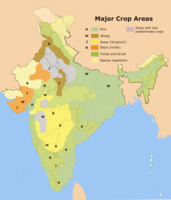
Photo from wikipedia
Shade indicates decreased sunlight. The agricultural importance of shade imparts to its deteriorative effect of crop yield. Rice is not only the most widely used food crop by a third… Click to show full abstract
Shade indicates decreased sunlight. The agricultural importance of shade imparts to its deteriorative effect of crop yield. Rice is not only the most widely used food crop by a third of the population of the world, but it has also been established as the model monocot plant for study. This article describes several important aspects of shade on rice yield with appropriate examples in other plants such as Arabidopsis . To start with, how different environmental or growth conditions create shade is explained. The morphological, physiological and biochemical characteristics due to different kinds of shade are selectively explained. The molecular characteristics of rice under shade from genetic, genomic and epigenetic studied are discussed. Signalling components for the manifestation of shade tolerance responses and their interconnection with other signalling networks and hormone pathway components are from recent reports. A list of genes, micro-RNAs and metabolites that are involved in shade responses is presented. Lastly, implications for sustainable yield under shade is discussed. This review will be useful not only for cutting-edge information on shade tolerance but will also build framework for upcoming new rice varieties with sustainable yield under shade.
Journal Title: Journal of Biosciences
Year Published: 2020
Link to full text (if available)
Share on Social Media: Sign Up to like & get
recommendations!